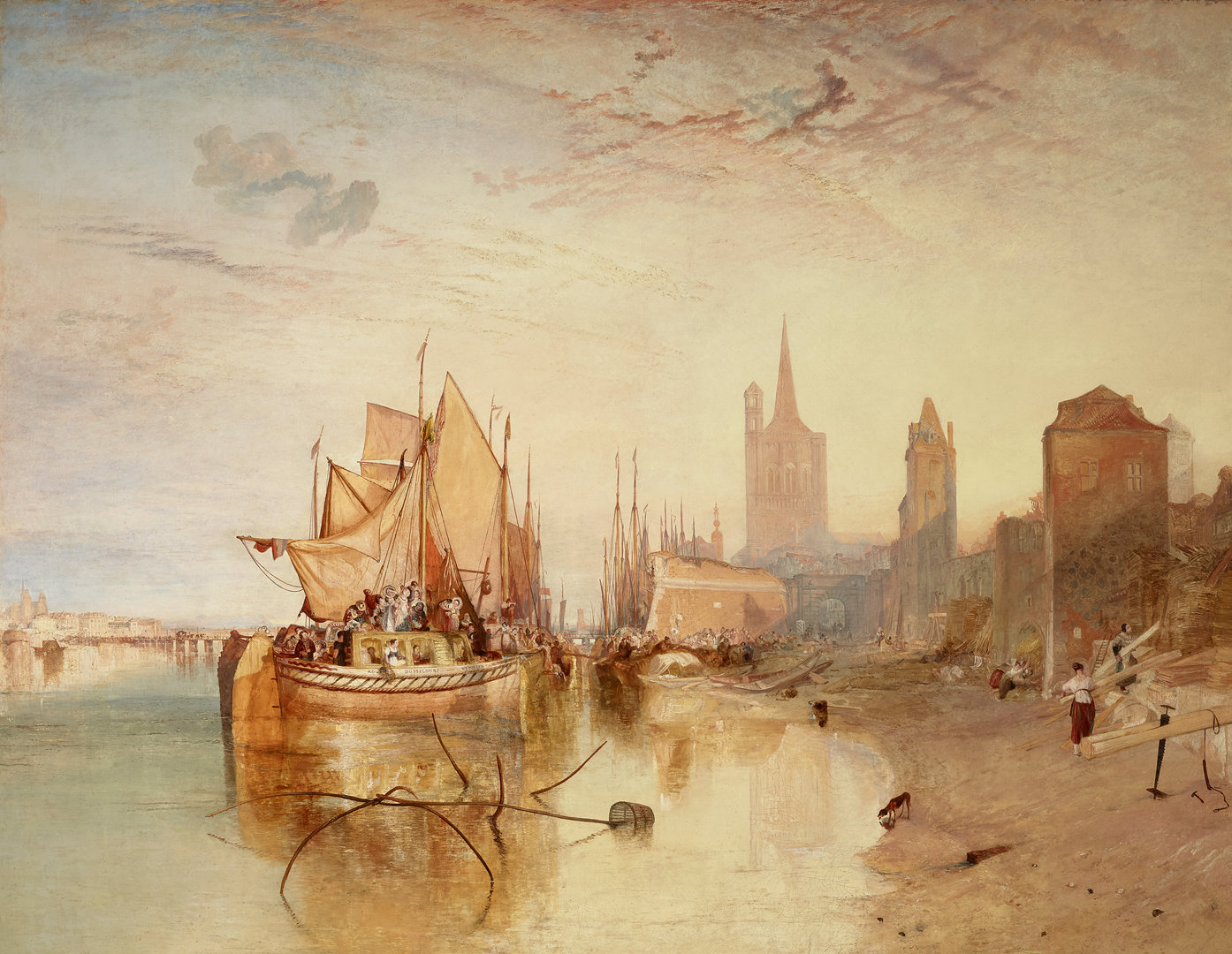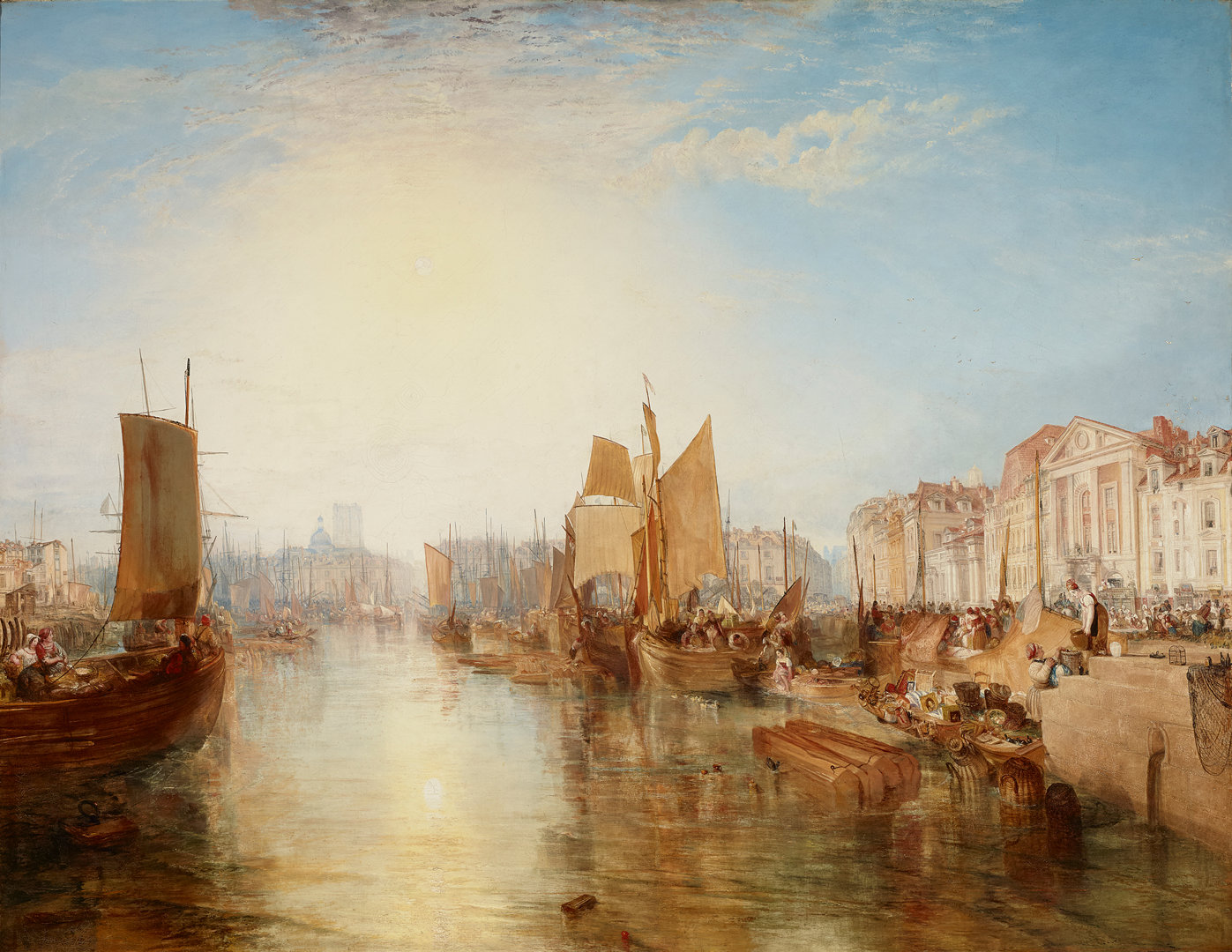Turner on Tour
Prized Turner paintings come back to Britain for the first time in a century
Issued July 2022
3 November 2022 – 19 February 2023
Room 46
Admission free
Two ground-breaking pictures by Joseph Mallord William Turner (1775–1851) will return to the UK for the first time in over 100 years, as part of a new National Gallery focus exhibition.
Generously lent for the first time by The Frick Collection in New York, the two oil paintings, will be on display at the Gallery in the Turner on Tour exhibition this winter (3 November 2022 – 19 February 2023).
'Harbour of Dieppe: Changement de Domicile' and 'Cologne, the Arrival of a Packet-Boat: Evening', painted in the mid-1820s, have not been seen in the UK since 1911. They were exhibited in New York in 1914 at the Knoedler Gallery, and subsequently acquired the same year by the American industrialist Henry Clay Frick. They have remained in the United States ever since.
'Dieppe' and 'Cologne' exemplify Turner’s life-long fascination with the subject of ports and harbours – past and present – as dynamic, transitional places. Exhibited at the Royal Academy in 1825 and 1826 respectively, they represent in powerfully visual terms, the outcomes of Turner’s regular sketching tours within Europe that were central to his fame as an artist-traveller, as well as his radical approach to colour, light and brushwork.
Turner visited the French fishing port of Dieppe, in Normandy, twice in the early 1820s before painting 'Harbour of Dieppe: Changement de Domicile' in his London studio.
Set in the afternoon, the work draws from sketches made on site, as well as from memory and imagination. In this Romantic view, signs of modernisation, such as the steamboats then in use, are excluded. Turner focuses on the vibrant energy of the town filled with glowing sunlight and hundreds of figures engaged in lively activities. He captured the details of local dress, studied the ships and their rigging up close and made detailed renderings of the town’s architecture. The French subtitles Turner assigned the painting – ‘Changement de Domicile’ (change of home address) – may refer to the couple to the right, who appear to be loading or unloading objects from boats.
Turner elevates his genre scene through the monumental scale of the canvas and the compositional format borrowed from the grand seaports of Claude (1604/5?–1682) . Here, as in Claude’s paintings, a central depiction of the sun reflected on water draws the eye back in space, while two arms of the town, with its buildings and boats, reach around it. The diminishing scale of the sails creates the illusion of depth. Another Claudian device is the use of light to create aerial perspective, whereby the haze created by sunlight makes the objects in the distance lose their focus and local colour and merge with a pale bluish grey sky.
Turner’s fascination with light during this period was inspired by a visit to Italy he made in 1819. Turner’s contemporaries noted this tendency to idealise the Italian countryside as some sort of pastoral idyll in contrast to the more industrialised landscape of the north. Journalists of the time deplored his pervasive use of yellow and criticised him for transposing a Mediterranean light and its golden tones onto a Northern European setting.
Turner exhibited this painting at the Royal Academy in 1825, but completed it and subsequently dated it 1826, the year when its companion piece Cologne: The Arrival of a Packet Boat: Evening, set at dusk, was shown at the Royal Academy.
A former Roman colony and a free, imperial city during the Holy Roman Empire, Cologne had long been a major commercial, educational, and religious centre. Situated on the banks of the Rhine, Cologne was still largely medieval in appearance when Turner visited. Only a small section of the city is visible in his painting: the tower and spire of the church of Groß St. Martin piercing the evening sky, with defensive towers, walls, and the customs house leading up to it. The labouring women in peasant dress and the abandoned fishing contraption contribute to a sense of time standing still. The ferry boat carrying female tourists to shore is about to disturb the peace of the scene.
These paintings were made at a time when Turner was experimenting with the representation of light and they offer a fascinating glimpse into his technique as well as the everyday life of major European ports of distinctly different regions.
In many ways, the story these paintings tell is less about a place, than it is about Turner’s increasing fascination with the dramatic effects of sunlight which becomes a significantly more important motif in Turner’s later works.
Whether or not his last words were indeed, as legend has it, ‘The sun is God,’ these words and by extension these paintings seem to sum up Turner’s artistic quest.
Turner on Tour is the third exhibition in Room 46 this year after Gainsborough’s Blue Boy (25 January 2022 – 15 May 2022) and Picasso Ingres: Face to Face (3 June 2022 – 9 October 2022) featuring rarely loaned paintings from American institutions.
Christine Riding, Jacob Rothschild Head of the Curatorial Department, says: ‘I am absolutely delighted that these wonderful paintings by Turner, one of the best loved artists in Britain, are going to be returning to the UK for the first time in more than 100 years and will be seen in Trafalgar Square, where they are sure to be hugely popular. The National Gallery was the home of the Turner Bequest so this is the perfect location for people to enjoy getting reacquainted with such masterpieces in person.’
National Gallery Director, Dr Gabriele Finaldi, says ‘Turner’s glorious river and harbour scenes from the Frick Collection are, through a special set of circumstances, coming to London for an unprecedented showing at the National Gallery. I am enormously grateful to our friends at the Frick for sharing their masterpieces with us.’
The H J Hyams Exhibition Programme
Supported by The Capricorn Foundation
For more information, visit nationalgallery.org.uk
Twitter @nationalgallery
Facebook @thenationalgallery
Instagram #nationalgallery
YouTube The National Gallery
Notes to editors
Press view: Tuesday 1st November 2022
Images
X11546
Joseph Mallord William Turner
'Harbour of Dieppe: Changement de Domicile'
Exhibited 1825, but subsequently dated 1826
Oil on canvas
173.7cm x 225.4 cm
The Frick Collection, New York
© The Frick Collection, New York / photo Michael Bodycomb
X11545
Joseph Mallord William Turner
'Cologne, the Arrival of a Packet-Boat: Evening'
1826
Oil on canvas
168.6 x 224.2 cm
The Frick Collection, New York
© The Frick Collection, New York / photo Michael Bodycomb
Publication
Title: 'Turner on Tour'
Authors: Christine Riding
With contributions by Thomas Ardill and Aimee Ng
64 pages, c. 43 illustrations tbc, 270 x 230 mm, portrait
Paperback with flaps: £14.95, special Gallery price: £12.95
Published by National Gallery Global, London
Distributed by Yale University Press
About Joseph Mallord William Turner (1775–1851)
Joseph Mallord William Turner, 19th-century Britain’s greatest land- and seascape artist, is perhaps the best-loved English Romantic artist. He became known as 'the painter of light', because of his increasing interest in brilliant colours as the main constituent in his landscapes and seascapes. His works include water colours, oils and engravings.
Turner was born in Maiden Lane, Covent Garden in London. The son of a London barber and wig maker, Turner entered the Royal Academy Schools in 1789 at the age of 14. As a youth, he travelled around England making drawings and watercolours of the countryside. He exhibited watercolours at the Royal Academy from 1790, and in 1796, Turner exhibited his first oil painting at the Royal Academy. In 1799, he was elected an associate member of the Royal Academy at the age of 24 - the youngest permitted age - and in 1802, he was elected a full member. That year, wartime borders with Europe temporarily opened, and he travelled abroad for the first time, visiting France and Switzerland. For the rest of his life, when it was possible, Turner travelled extensively around Europe, drawing in sketchbooks and producing paintings from them back in his studio in England.
His earliest works form part of the 18th-century topographical tradition. He was soon inspired by 17th-century Dutch artists such as Willem van der Velde, and by the Italianate landscapes of Claude and Richard Wilson.
He depicted ports throughout his career, both in monumental oil paintings and in watercolours. An insatiable traveller and an artist with a deep fascination with light, topography, and local traditions, as well as with classical antiquity, Turner brought an innovative approach to the depiction of both modern and ancient ports.
Turner became interested in contemporary technology, as can be seen from The Fighting Temeraire and Rain, Steam and Speed. At the time his free, expressive treatment of these subjects was criticised, but it is now widely appreciated. In his art, he recorded England’s landscape as it evolved over decades of intense industrialisation.
He was both widely acclaimed by his contemporaries and attacked by critics, especially for his late, more abstract and experimental works. He had acquired great wealth by the time of his death of cholera at the age of 76.
Turner bequeathed much of his work to the nation. The great majority of the paintings are now at Tate Britain.
Also on display at the National Gallery at the same time:
Winslow Homer: Force of Nature (10 September 2022 – 8 January 2023)
Lucian Freud: New Perspectives (1 October 2022 – 22 January 2023)
Publicity images can be obtained from https://press.nationalgallery.org.uk/
For more information and images
E-mail National Gallery Press Office at press.external@ng-london.org.uk


